1.Characteristics of life
2. Atoms to Molecules
Elements
Atoms
Isotopes
Compounds
3. Molecules of Life
Carbohydrates
Lipids
Proteins
Nucleic Acids
4. Cell Structures
Evolution of Cells
Prokaryotic and Eukaryotic Cells
Internal Structure of Eukaryotic Cells
Cytoskeleton
Nucleus
Endoplasmic Reticulum
Plasma Membrane
5. Nucleus and the production of proteins
Nucleus
Ribosomes
Endomembrane System
Golgi Apparatus
Lysosomes
6.Cytoskeleton and Cell Movement
Cytoskeleton
Cell Movement
7.Mitochondria
8.Cellular Respirations and Metabolism
Cell Metabolism
Cellular Respiration
9.Tissue Types
Connective Tissue
Muscular Tissue
Nervous Tissue
Epithelial Tissue
10.Cell Junctions
Tight Junction
Adhesive Junction
Gap Junction
11.Organ Systems
Integumentary System
Cardiovascular System
Lymphatic and Immune System
Digestive System
Respiratory System
Urinary System
Skeletal System
Muscular System
Nervous System
Endocrine System
Reproductive System
12.Body Cavities
1. Characteristics of Life
- Life is organized from the smallest unit: the atom to the largest unit: the biosphere.
- There are 11 levels of organization
- Atom: made of electrons, protons, and neutrons.
- Molecule: made up of two or more combined atoms.
- Cell: is the building block of life. It is made up of a combination of molecules.
- Tissue: is a group of cells that share the same characteristics.
- Organs: are different tissues that work together to perform a specific job.
- Organ Systems: is a group of organs that work together.
- Organism: is a living animal that has organ systems.
- Population: is a group of similar organisms (species) that live in a specific area.
- Community: is a group of different species that live (share) a specific area or place.
- Ecosystem: is the community plus the environment.
- Biosphere: is made up of all the different ecosystems.
- Life needs materials and energy from the environment.
- All animals get materials and energy from food.
- Food provides nutrient molecules.
- Nutrient molecules are used to make energy for all organisms
- Life must reproduce
- A new organism is made from a pre-existing cell.
- A copy of the cell is made through DNA molecules.
- Life must grow and develop.
- Growth is the multiplying of cells.
- Development is the stages of growth that an organism goes through.
- All organisms go through development and growth.
- Life must be homeostatic.
- Organ systems maintain homeostasis.
- Homeostasis is a set of limits for the internal environment to maintain life.
- Life must respond to stimuli.
- Organisms respond to internal and external stimuli.
- External stimuli cause an organism to move towards or away from the stimuli.
- Internal stimuli have sensory receptors that detect changes and cause the nervous system to prompt a response internally.
- Life has an evolutionary history.
- Evolution is the different stages an organism has gone through to adapt to the environment.
- All organisms share the same characteristics of life.
- Organisms are different because of the need to adapt to different ways of life.
- Humans are related to other animals.
- Three classifications
- Eukarya: animals, plants, fungi, protista. Cells have a membrane-bounded nucleus.
- Archaea: do not have a membrane-bounded nucleus.
- Bacteria: do not have a membrane-bounded nucleus.
2. Atoms to molecules
- Elements
- Are the building blocks of matter.
- Can not be broken down by chemical means
- 92 elements occur naturally.
- 90% of the human body is made with 4 elements:
- carbon, nitrogen, oxygen, hydrogen
- Each element has an assigned atomic symbol.
- Atoms
- Are the smallest unit that is used to make a chemical reaction.
- Has a nucleus.
- Inside the nucleus are protons and neutrons.
- Protons have a positive charge.
- Neutrons have a negative charge.
- Electrons are located outside the nucleus.
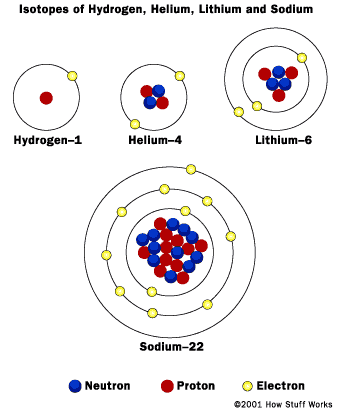
- Atomic Numbers tell how many protons are in an atom.
- Atoms have the same number of protons, neutrons, and electrons when it is electrically neutral.
- Electrons are organized around the nucleus in shells.
- The first shell holds 2 electrons and is closest to the nucleus.
- All remaining shells hold up to 8 electrons each .

- Mass is the amount of matter in each atom.
- Protons and neutrons are equal to 1 atomic mass unit.
- To determine how many neutrons in an atom, subtract the atomic number from the atomic mass.
- Isotopes
- Are the same type of atom that has a different amount of neutrons and atomic mass.
- Radioisotypes
- Are unstable isotopes that breakdown over time.
- When broken down many types of rays and subatomic particles are released.
- Compounds
- Are made when two types of Atoms bond together.
- Two types of bonds
- Ionic Bonds
- The attraction between negative and positive ions forms the ionic bond.
- Atoms give up or take on electrons to become stable.
- They are stable when they have 8 electrons in their outer shell.
- If there are more electrons and less protons there will be a negative charge.
- If there are less electrons and more protons there will be a positive charge.
- Covalent Bonds
- Atoms share electrons in the outer shell.
- Double bond: 2 pair of electrons are shared.
- Triple bond: 3 pair of electrons are shared.
3. Molecules of Life
- Four categories of organic molecules.
- Carbohydrates
- The ratio of hydrogen atoms to oxygen atoms is 2:1
- Function for quick and short-term energy storage.
- Two types:
- Simple Carbohydrates
- Monosaccharide: 3 to 7-carbon sugar.
- Pentose: 5-carbon sugar.
- Hexose: 6-carbon sugar.
- Glucose- an immediate source of energy
- Fructose- found in fruit
- Galactose-constituent of milk
- Diasaccharide
- 2 monosaccharides combined
- Maltose is a disaccharide made with 2 glucose molecules.
- Complex Carbohydrates
- Polysaccharides- contain many glucose units.
- Starch, glycogen, cellulose
- Lipids
- Do not dissolve in water, they have an absence of polar groups.
- Consist mostly of Carbon and Hydrogen atoms
- Fats and Oils are the most common lipids.
- Are formed when 1 glycerol molecule reacts with 3-fatty acid molecules.
- Are used for long-term energy storage.
- Insulates body against heat loss.
- Forms protective cushion around major organs.
- Fats
- Usually of animal origin
- Solid at room temperature
- Oils
- Usually plant derived
- Liquid at room temperature
- Phospholipids
- Constructed like fats, except there is a phosphate group or grouping of phosphate and nitrogen in place of the 3rd fatty acid.
- Are not electrically neutral.
- Are the primary components of cellular membranes.

- Steroids
- Have a base of 4 fused carbon rings.
- Each steroid differs by the functional groups attached to the carbon rings.
- 2 types: testosterone and estrogen
- Proteins
- Are the main molecules for structure and function of cells.
- Functions in humans are:
- Support: keratin makes collagen, which lends support to ligaments, tendons, and skin.
- Enzymes: bring reactants together to speed up chemical reactions.
- Transport: Channel and carrier proteins in the plasma membrane allow substance to enter and exit cells.
- Defense: Proteins are combined with antigens to create antibodies. They prevent the destruction of cells.
- Hormones: are regulatory proteins, they function as messengers that influence metabolism.
- Motions: Actin and Myosin proteins allow parts of cells to move and cause muscles to contract.
- Amino Acids:
- Are the subunits of protein.
- The main carbon atom in protein bonds to a hydrogen atom and to 3 other groups of atoms:
- Amino group
- Acid Group
- R Group
- R group changes the type of amino acid
- Protein Organization
- There are 4 levels of organization
- Primary structure: is a linear sequence of amino acids that are joined with peptide bonds.
- Secondary Structure: is a polypeptide that takes on a specific structure; a coiling of the chain is created from the bonding of 2 different amino acids.
- Tertiary Structure: Is the final 3-dimensional shape; different types of bonding between the R groups maintain the shape. Covalent, Ionic, and Hydrogen bonding occur.
- Quaternary Structure: Proteins that have more than 1 polypeptide with it’s own primary, secondary, and tertiary structures. These separate polypeptides arrange to make the 4th level.
- Nucleic Acids
- DNA contains genes. The genes specify the sequence of amino acids.
- RNA relay’s DNA’s instructions.
- Structure of DNA and RNA
- Nucleotide Structure
- DNA and RNA are polymers of nucleotides.
- Nucleotide is a molecular complex of 3 types of subunit molecules.
- Phosphate
- Pentose Sugar
- Nitrogen containing base.
- Nucleotides in DNA contain the sugar deoxyribose
- Nucleotides in RNA contain the sugar ribose.
- 4 bases in DNA
- adenine (A)
- thymine (T)
- guanine (G)
- cytosine (C)
- 4 bases in RNA
- adenine (A)
- uracil (U)
- guanine (G)
- cytosine (C)
- Polynucleotide Structure
- Nucleotides form a polynucleotide called a strand.
- The strand has a backbone made of phophate-suar-phosphate-sugar.
- The bases (A,T,G,C,U)are out to one side of the backbone.
- The bases always occur in a specific and set order.
- DNA structure
- Double stranded, forms a helix. When straightnend it looks like a ladder.
- The 2 strands are held together by hydrogen bonds.
- The sides are made of phosphate and sugar molecules.
- The rungs are made of complimentary paired bases.
- Thymine and Adenine
- Guanine and Cytosine.
- ATP: Adenosine Triphosphate
- Is an energy carrier
- Is made of adenosine plus 3 phosphate groups.
- High energy molecule
- Last 2 phosphate bonds are unstable
- Energy released by breakdown is used to synthesize macromolecules.
- An input of energy is required to re-form ATP.
4. Cell Structure
- Evolution of Cells
- Prokaryotic Cells: 1st cells, lack a nucleus
- Bacteria and Archaea
- Eukaryotic Cells: have a nucleus
- Evolved from archaea
- Prokaryotic and Eukaryotic Cells
- Plasma Membrane
- Regulates what enters and exits the cell
- Is a phospholipid bilayer
- Selectively permeable
- Cytoplasm
- Semi-fluid containing water and different types of molecules
- Contains organelles
- Eukaryotic Cells: contain many types
- Prokaryotic Cells: have 1 or 2 types
- Internal Structure of Eukaryotic Cells
- Cytoskeleton maintains cell shape and helps movements of cell parts.
- Microtubules: cylinders of protein molecules present in cytoplasm, centrioles, cilia, and flagella.
- Intermediate filaments: protein fibers that provide support and strength.
- Actin filaments: protein fibers that play a role in movement of cell and organelles.
- Centrioles: short cylinders of microtubules of unknown function.
- Centrosome: microtubule organizing center that contains a pair of centrioles.
- Lysosome: a vesicle that digests macromolecules and cell parts.
- Vesicle: membrane-bounded sac that stores and transports substances.
- Cytoplasm: semi-fluid matrix outside the nucleus that contains organelles.
- Nucleus
- Nuclear Envelope: double membrane with nuclear pores that encloses the nucleus.
- Chromatin: diffuse threads that contain DNA and protein.
- Nucleolus: a region that produces subunits of ribosomes.
- Endoplasmic Reticulum (ER)
- Rough ER: studded with ribosomes.
- Smooth ER: no ribosomes, synthesizes lipid molecules.
- Mitochondrion: organelle that carries out cellular respiration, produces ATP molecules.
- Polyribosomes: a string of ribosomes simultaneously synthesizing the same protein.
- Golgi Apparatus: processes, packages, and secretes modified cell parts.
- Plasma Membrane
- Keeps a cell intact.
- Allows only certain molecules and ions to enter and exit the cytoplasm(selectively permeable).
- Lipid soluble molecules can easily pass through the membrane using aquaporins (protein channels).
- How cells cross the plasma Membrane:
- Diffusion:
- The movement of molecules from a higher concentration to a lower concentration until they are equally distributed.
- Is a passive way for molecules to enter and exit a cell.
- No energy is needed.
- Osmosis
- The diffusion of water across the plasma membrane.
- Process involves water and a solute( a dissolved substance)that can’t readily pass across the membrane.
- Hypotonic: solutes that cause cells to swell or burst due to water intake.
- Hypertonic: solutions that cause cells to shrink or shrivel from loss of water
- Osmotic Pressure: the force exerted on a selectively permeable membrane when water moves from area of higher to lower concentration of water causing a higher concentration of solute.
- Facilitated Transport
- Protein carriers within the membrane transport solutes.
- Molecules are transported from higher to lower concentration.
- Active Transport
- Molecules move from lower to higher concentration.
- The process requires a protein carrier and the use of energy from the breakdown of ATP molecules.
- Endocytosis and Exocytosis
- Endocytosis
- A portion of the plasma membrane envelops a substance and fluid. The membrane pinches off to form an endocytic vesicle in the cell.
- Phagocytosis: white blood cells take up pathogens with Endocytosis.
- Exocytosis
- A vesicle fuses with the plasma membrane as secretions occur.
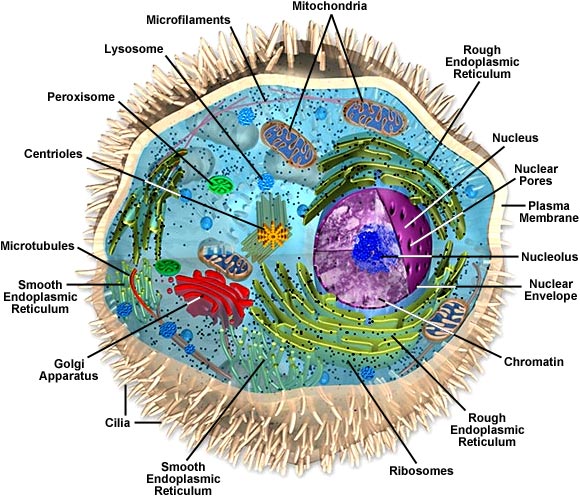
5. Nucleus and the production of Proteins
- Nucleus
- Stores the genetic information of the cell.
- Chromatin: transform into chromosomes just before cell division.
- Chromosomes: Contains a DNA molecule and proteins.
- Nucleoplasm: semi fluid medium containing chromatin.
- Nuclear Envelope: double membrane that separates the nucleus from the cytoplasm.
- Nuclear pores: permit the passage of ribosomal subunits out of the nucleus and proteins into the nucleus
- Ribosomes
- Are composed of proteins and rRNA.
- Protein synthesis occurs at the ribosomes.
- They may be attached to the endoplasmic Reticulum or free within the cytoplasm, single or in groups(Polyribosomes)
- Endomembrane System
- Endoplasmic Reticulum
- Rough ER
- Studded with ribosomes on side of membrane facing the cytoplasm.
- Is where proteins are synthesized and enter the inside of the ER where processing and modification begin.
- Smooth ER
- Does not have attached ribosomes. Synthesizes the phospholipids that occur in membranes and performs other functions depending on the cell.
- Forms transport vesicles to transport large molecules to other pars of the cell
- Golgi Apparatus
- A stack of slightly curved saccules
- Proteins and lipids from the ER are modified.
- Involved in processing, packaging, and secretion
- Lysosomes
- Membraneous sacs produced by the Golgi apparatus, they contain hydrolytic enzymes.
- Found in all cells, they are concentrated in white blood cells.
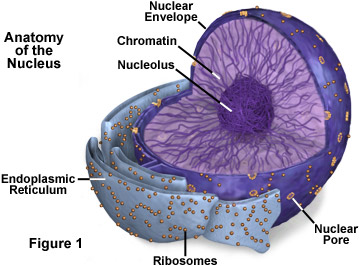
6. Cytoskeleton and Cell movement
- Cytoskeleton
- Made up of multiple types of criss-crossed protein fibers.
- Helps maintain cells shape.
- Anchors the organelles or assists in their movement.
- The parts of the cytoskeleton
- Microtubules
- Cylinder that contains 13 rows of a protein called tubulin.
- Centrosome
- Regulates the assembly of the microtubule.
- Is the organizing center of the microtubule.
- Actin filaments
- Are involved in movement: microvilli.
- Intermediate filaments
- Are in between microtubules and actin filaments in size.
- Their structure and function depend on the type of cell.
- Cell Movement
- Cilia and flagella are involved in movement.
- Cilia are 20x shorter than flagellum.
- Motormolecules powered by ATP allow the microtubules in cilia and flagella to interact and bend.
- Both are grown from basal bodies and share the same organization as centrioles.


7. Mitochondria
- Convert chemical energy of glucose products into chemical energy of ATP molecules.
- During the process they use oxygen and release carbon dioxide
- Process of producing ATP is called cellular respiration.
- Structure is appropriate to the task.
- Inner membrane is folded to form cristae
- The matrix contains enzymes that breakdown glucose products.
- ATP production occurs is the cristae.
- They have their own genes and reproduce themselves.

8. Cellular Respiration and Metabolism
- Cell Metabolism
- Requires metabolic pathways that are carried out by sequentially arranged enzymes.
- Each reaction requires a specific enzyme.
- Enzymes and Coenzymes
- Enzymes
- Substrates: are reactants that participate to speed up a reaction.
- Active Site: is where substrates are brought so that they can react.
- The shape of the active site causes enzyme specificity.
- Coenzymes
- Are nonprotein molecules that assist the activity of an enzyme, they may accept or give atoms to the reaction.
- Cellular Respiration
- Is the process of breaking down glucose into carbon dioxide and water.
- Pathways allow energy in a glucose molecule to be released slowly, causing ATP to be produced gradually.
- Three pathways are involved in the process
- Glycolysis
- Glucose is split into two 3-carbon molecules called pyruvate.
- Occurs in the cytoplasm
- Is anaerobic, it requires no oxygen.
- Hydrogen and electrons are removed from glucose leaving NADH
- The breaking of bonds makes 2 ATP molecules.
- When oxygen is available, the molecule enters the mitochondria and is completely broken down.
- When oxygen is not available fermentation occurs.
- Citric Acid Cycle
- Completes the breakdown of glucose.
- Is a series of enzymatic reactions that occur in the matrix of the mitochondria.
- Carbon dioxide is released in the process.
- NADH removes the hydrogen and electrons.
- The process produces 2 ATP per glucose molecule.
- Electron Transport Chain
- NADH delivers electrons to the chain.
- Carrier proteins accept 2 electrons and then pass the remaining to the next carrier.
- High-energy electrons enter the chain, as they go from carrier to carrier energy is depleted, low energy electrons emerge from the chain.
- Oxygen is the final acceptor of the low energy electrons.
- Once oxygen receives electrons it combines with hydrogen to make water.
9. Tissue Types
- Tissues are specialized cells of the same type that perform a common function in the body.
- Four types of tissues
- Connective tissue
- Fibrous Connective tissue
- Made of cells called fibroblasts
- 2 types:
- Loose fibrous connective tissue
- supports epithelium and many internal organs. It allows organs to expand.
- Forms protective coverings that enclose many internal organs.
- Adipose tissue
- Special type of loose connective tissue where cells enlarge and sore fat.
- Are found beneath the skin, around the kidneys, and the surface of the heart.
- Dense Fibrous Connective Tissue
- Contains collagen fibers that are packed together.
- Are found in tendons and ligaments.
- Supportive Connective Tissue
- Is distinguished by the type of fibers.
- 3 types:
- Hyaline Cartilage
- Most common of the three.
- Made with very fine collagen fibers
- Found in the nose, at the end of long bones and ribs, forms rings in the walls of respiratory passages.
- Elastic Cartilage
- Contains more elastic fibers than Hyaline cartilage.
- Found in the framework of the outer ear.
- Fibro Cartilage
- Contains strong cartilage fibers.
- Found in structures that with stand tension and pressure, the disks between the vertebrae and the wedges in the knee joint.
- Bone
- Most rigid connective tissue
- 2 types make up the bone
- Compact Bone
- Makes up the shaft of the long bone
- Spongy Bone
- The ends of the long bone
- Fluid Connective Tissue
- There are 2 types
- Blood
- Red Blood Cells
- Transport oxygen
- White Blood Cells
- Fight infection.
- Platelets
- Fragments of giant cells present only in bone marrow.
- Help blood clot.
- Lymph
- Is a clear watery fluid containing White Blood Cells
- Lymphatic vessels absorb excess tissue, fluid, and various dissolved solutes in the tissues and transports to particular vessels of the cardiovascular system.
- Muscular Tissue
- Composed of cells called muscle fibers.
- Actin and Myosin interactions cause movement.
- 3 types
- Skeletal Muscle (Voluntary Muscle)
- Attached to the bones by tendons
- When muscle contracts is causes movement
- Muscle fibers are long and cylindrical.
- Are developed when multiple cells fuse together creating 1 fiber with multiple nuclei.
- Fibers have alternating bands of actin and myosin filaments giving them a striated appearance.
- Smooth Muscle (Visceral)
- Made up of layers of spindle shaped cells, each layer has a nucleus.
- Functions in movement of substances in the lumens of the body.
- Is an involuntary muscle.
- Is found inside blood vessels and digestive tract walls.
- Cardiac Muscle
- Is found only inside the walls of the heart.
- Has branching striated cells, each with a single nucleus.
- Functions is the pumping of the blood.
- Is involuntary.

- Nervous Tissue
- Consists of neurons and neuroglia
- Neurons
- Have 3 parts:
- Dendrites: an extension that receives signals from sensory receptors or other neurons.
- Cell Body: contains the cells cytoplasm and nucleus
- Axon: and extension that conducts nerve impulses. Long axons are covered by myelin.
- Has 3 functions
- Sensory input
- Integration of data
- Motor output

- Neurolgia
- Cells outnumber neurons 9:1 and take up more than half the volume of the brain.
- The primary function is to support and nourish neurons.
- 4 types:
- Microglia: support neurons, engulf bacterial and cellular debris.
- Astrocytes: provide nutrients to neurons, produces the growth hormone: gila derived growth factor.
- Oligodendrocytes: form the myelin sheath around the fibers in the brain and spinal cord.
- Schwann Cells: are outside the brain, they encircle long nerve fibers and form a myelin sheath.
- Epithelial Tissue
- Tightly packed cells that form a continuous layer
- Covers surfaces and lines cavities.
- One side is exposed to the environment and the other side is bounded by a basement membrane.
- Basement Membrane is a thin layer of various types of carbohydrates and proteins that connects epithelium to under lying connective tissue.
- 5 Types
- Simple Epithelia
- Is a single layer of cells.
- Is classified into 3 types:
- Squamous epithelium
- Flattened cells
- Lines the air sacs of lungs and walls of blood vessels.
- Their shape and arrangement allows the exchange of substances.
- Cubiodal Epithelium
- Single layer of cube shaped cells.
- Found in glands, covers the ovaries, lines the kidneys tubules.
- Involved in absorption
- Functions in active transport.
- Columnar Epithelium
- Resembles rectangular pillars or columns, nuclei are located near the bottom of each cell.
- Lines the digestive tract, microvilli expand the surface area and help absorb the products of digestion.
- Ciliated columnar epithelium are found lining the oviducts.
- Pseudostratified Columnar Epithelium
- Appears to be layered but is not.
- Each cell touches the basement membrane
- Nuclei are irregularly placed
- Are found in the lining of the windpipe and trachea.
- Transitional Epithelium
- Changes in response to tension
- Forms the lining of the urinary bladder, the ureters, and part of the urethra.
- Similar to columnar epithelium
- Stratified Epithelium
- Formed by layers of cells on top of each other.
- Only the bottom layer touches the basement membrane.
- Lines the mouth, nose, esophagus, anal canal, outer portion of the cervix, and the vagina.
- Is the outer layer of skin that is reinforced by keratin.
- Stratified cuboidal and stratified columnar epithelia are also found in the body.
- Glandular Epithelia
- Is when a epithelium secretes a product
- Glands may be just a single epithelial cell or it may be multiple cells.
- 2 types of glands:
- exocrine glands- secretes product onto outer surface or into a cavity
- Endocrine Glands-no ducts, secretes hormones internally that are transported by the blood stream.
- Connects tissues to help perform its particular function.
- Are formed when plasma membranes are joined
- Can be joined in three ways:
- Tight Junctions
- Allows epithelial cells to form a layer that covers the surface of organs and lines body cavities.
- Adjacent plasma membrane proteins join producing a ziperlike fastening.
- Adhesive Junctions
- Attaches Cytoskeletal fibers of one cell to another.
- Common in tissues subject to mechanical stress
- Allows skin to stretch and bend in response to mechanical stress.
- Gap Junctions
- Occurs when adjacent plasma membranes join and leave a small channel between them.
- Integumentary System
- Skin, nails, hair, oil and sweat glands, blood vessels, nerves leading to sensory receptors.
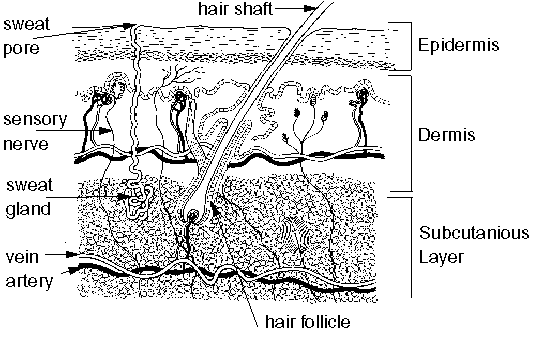
- Cardiovascular System
- Heart pumps blood through the blood vessels, transporting nutrients and oxygen and removing waste molecules and carbon dioxide.

- Lymphatic and Immune System
- Lymphatic System
- Consists of lymphatic vessels, lymph nodes, the spleen, and other lymphatic organs.
- Collects excess tissue fluid and plays a role in absorbing fats and transporting lymph to the cardiovascular veins.

- Immune System
- Consists of all cells in the body that protect us form disease (lymphocytes)

- Digestive System
- Consists of the mouth, esophagus, stomach, small intestines, and large intestines.
- Associated organs: teeth, tongue, salivary glands, liver, gallbladder, and pancreas.
- Receives food and digests it into nutrient molecules.
- Respiratory System
- Lungs
- Brings oxygen into the body and removes carbon dioxide from the body

- Urinary System
- Kidneys, urinary bladder
- Rids the body of waste products.

- Skeletal System
- Bones protect body parts( skull, ribs)
- Stores minerals
- Produces blood cells in the red bone marrow.

- Muscular System
- Skeletal muscle contraction maintains posture and accounts for the movement of the body and its parts.
- Cardiac muscle works the heart
- Smooth muscle allows the internal organs to contract

- Nervous System
- Consists of the brain, spinal cord, and associated nerves.
- Allows us to respond to external and internal stimuli
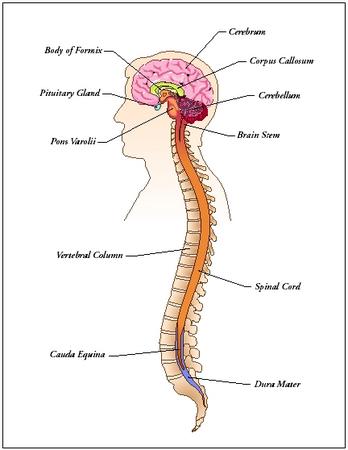
- Endocrine System
- Consists of hormonal glands
- Secretes chemical messengers called hormones into the blood stream
- Maintains functioning of the male and female reproductive organs

- Reproductive System
- Male: Testes and other glands and ducts that conduct semen to and through the penis.

- Female: ovaries, oviducts, uterus, vagina, external genitals.

12. Body cavities
- 2 Main cavities
- Ventral Cavity
- Has three cavities
- Thoracic Cavity: heart, lungs, esophagus
- Abdominal Cavity: stomach, liver, spleen, pancreas, gallbladder, intestines
- Pelvic Cavity: rectum, urinary bladder, reproductive organs
- Dorsal Cavity
- Cranial Cavity: brain
- Vertebral Canal: spinal cord


2 comments:
I really liked your whole thing. Your blog looks great and on your cell model you had directional arrows that helped in moving the eye throughout the process of cellular inner workings. I thought it was interesting to see eveyone's interpretation of how to make the cell. Using the ribbon was spot on! Some of the pictures on your blog did not show up on my page for me to see. I am not sure why. I liked the way you further explained the dragon microscope lab with wing types and dominate verses recessive genes. I think you did a fab job and I thought your blog was easy to follow through and read. My goodness, so I know this is a bit off subject, but your baby is absolutely adorable. Sorry I just had to say that!
Hi Nice Blog . In this, the body is studied by regions rather than by organs. This is of importance to the surgeon who exposes different planes after the skin incision and who, of course, must be perfectly familiar with structures as he explores the limbs and human endocrine systemcavities.
Post a Comment